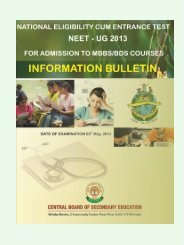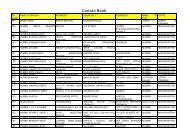Examination Syllabus - NEET-UG, 2013
Examination Syllabus - NEET-UG, 2013
Examination Syllabus - NEET-UG, 2013
Create successful ePaper yourself
Turn your PDF publications into a flip-book with our unique Google optimized e-Paper software.
UNIT IV: Human Physiology<br />
Digestion and absorption; Alimentary canal and digestive glands; Role of digestive enzymes and gastrointestinal hormones;<br />
Peristalsis, digestion, absorption and assimilation of proteins, carbohydrates and fats; Caloric value of proteins, carbohydrates and<br />
fats; Egestion; Nutritional and digestive disorders – PEM, indigestion, constipation, vomiting, jaundice, diarrhea.<br />
Breathing and Respiration: Respiratory organs in animals (recall only); Respiratory system in humans; Mechanism of breathing and<br />
its regulation in humans-Exchange of gases, transport of gases and regulation of respiration Respiratory volumes; Disorders related<br />
to respiration-Asthma, Emphysema, Occupational respiratory disorders.<br />
Body fluids and circulation: Composition of blood, blood groups, coagulation of blood; Composition of lymph and its function;<br />
Human circulatory system-Structure of human heart and blood vessels; Cardiac cycle, cardiac output, ECG, Double circulation;<br />
Regulation of cardiac activity; Disorders of circulatory system-Hypertension, Coronary artery disease, Angina pectoris, Heart<br />
failure.<br />
Excretory products and their elimination: Modes of excretion- Ammonotelism, ureotelism, uricotelism; Human excretory systemstructure<br />
and fuction; Urine formation, Osmoregulation; Regulation of kidney function-Renin-angiotensin, Atrial Natriuretic Factor,<br />
ADH and Diabetes insipidus; Role of other organs in excretion; Disorders; Uraemia, Renal failure, Renal calculi, Nephritis; Dialysis<br />
and artificial kidney.<br />
Locomotion and Movement: Types of movement- ciliary, fiagellar, muscular; Skeletal muscle- contractile proteins and muscle<br />
contraction; Skeletal system and its functions (To be dealt with the relevant practical of Practical syllabus); Joints; Disorders of<br />
muscular and skeletal system-Myasthenia gravis, Tetany, Muscular dystrophy, Arthritis, Osteoporosis, Gout.<br />
Neural control and coordination: Neuron and nerves; Nervous system in humans- central nervous system, peripheral nervous<br />
system and visceral nervous system; Generation and conduction of nerve impulse; Reflex action; Sense organs; Elementary<br />
structure and function of eye and ear.<br />
Chemical coordination and regulation: Endocrine glands and hormones; Human endocrine system-Hypothalamus, Pituitary, Pineal,<br />
Thyroid, Parathyroid, Adrenal, Pancreas, Gonads; Mechanism of hormone action (Elementary Idea); Role of hormones as<br />
messengers and regulators, Hypo-and hyperactivity and related disorders (Common disorders e.g. Dwarfism, Acromegaly,<br />
Cretinism, goiter, exopthalmic goiter, diabetes, Addison’s disease).<br />
UNIT I: Reproduction<br />
(Imp: Diseases and disorders mentioned above to be dealt in brief.)<br />
CONTENTS OF CLASS XII SYLLABUS<br />
Reproduction in organisms: Reproduction, a characteristic feature of all organisms for continuation of species; Modes of<br />
reproduction – Asexual and sexual; Asexual reproduction; Modes-Binary fission, sporulation, budding, gemmule,<br />
fragmentation; vegetative propagation in plants.<br />
Sexual reproduction in flowering plants: Flower structure; Development of male and female gametophytes; Pollination-types,<br />
agencies and examples; Outbreeding devices; Pollen-Pistil interaction; Double fertilization; Post fertilization events-<br />
Development of endosperm and embryo, Development of seed and formation of fruit; Special modes-apomixis,<br />
parthenocarpy, polyembryony; Significance of seed and fruit formation.<br />
Human Reproduction: Male and female reproductive systems; Microscopic anatomy of testis and ovary; Gametogenesisspermatogenesis<br />
& oogenesis; Menstrual cycle; Fertilisation, embryo development upto blastocyst formation, implantation;<br />
Pregnancy and placenta formation (Elementary idea); Parturition (Elementary idea); Lactation (Elementary idea).<br />
Reproductive health: Need for reproductive health and prevention of sexually transmitted diseases (STD); Birth control-Need<br />
and Methods, Contraception and Medical Termination of Pregnancy (MTP); Amniocentesis; Infertility and assisted<br />
reproductive technologies – IVF, ZIFT, GIFT (Elementary idea for general awareness).





